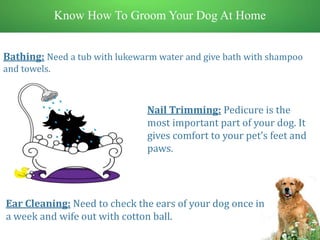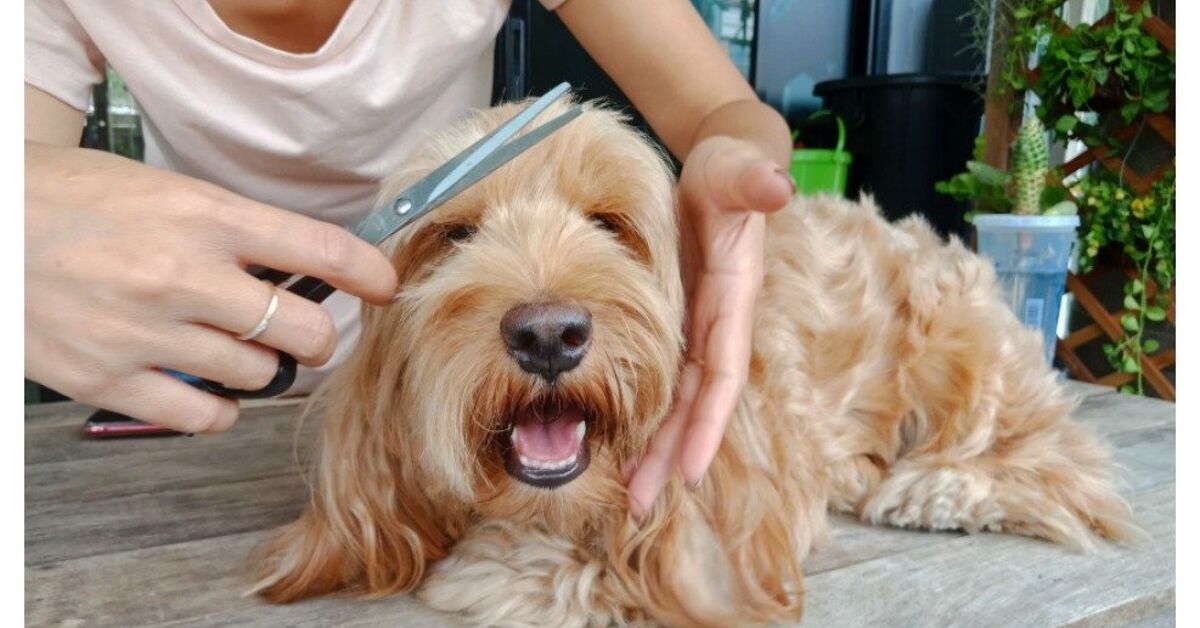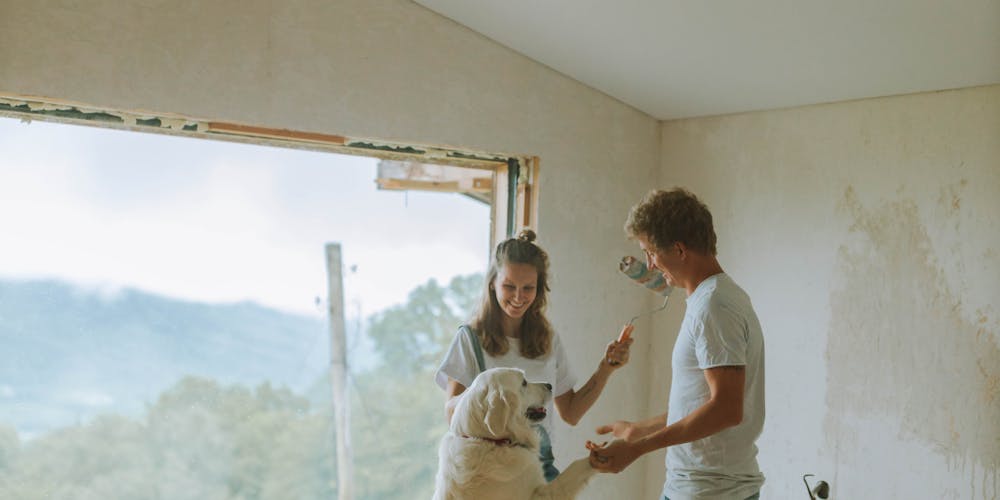Grooming your dog is an essential part of being a responsible pet owner. It not only keeps them looking good, but it also promotes good health and well-being. Going to a professional groomer can be expensive and time-consuming, but with the right tools and techniques, you can easily groom your dog at home. In this article, we will guide you through the process of grooming your dog at home, from bathing to trimming their nails. By following these steps, you can save money and bond with your furry friend in the comfort of your own home.
1. Preparing for the Grooming Session

Before starting the grooming process, it's important to gather all the necessary tools and prepare your dog for the session.
Tools Needed:
- Dog shampoo: Choose a mild, pH-balanced shampoo specifically made for dogs. Avoid using human shampoos as they can be harsh on your dog's skin.
- Brush/comb: Depending on your dog's coat type, choose a brush or comb that is suitable for their hair.
- Towels: Have a few clean towels ready for drying your dog after the bath.
- Clippers/trimmers: If you plan on trimming your dog's hair, invest in a good quality clipper or trimmer.
- Nail trimmer: Opt for a nail trimmer made specifically for dogs, as human nail clippers can be too small and may cause injury.
- Styptic powder: In case you accidentally cut your dog's nail too short, have some styptic powder on hand to stop any bleeding.
- Cotton balls: These can come in handy for cleaning your dog's ears.
- Treats: It's always a good idea to reward your dog with treats throughout the grooming process to make it a positive experience for them.
Preparing Your Dog:
Before starting the grooming session, it's important to get your dog used to the process. Start by slowly introducing them to each tool and reward them with treats when they show calm behavior. Once they are comfortable, you can proceed with the grooming session.
2. Bathing Your Dog

Bathing your dog is an essential part of grooming as it not only keeps them clean but also helps in reducing shedding and preventing skin infections. Here's how you can bathe your dog at home:
Step 1: Brush Your Dog's Coat
Start by brushing your dog's coat to remove any knots or mats. This will also help in removing any loose fur before the bath.
Step 2: Prepare the Bathing Area
Choose a suitable area for bathing your dog, such as a bathtub, sink, or a large basin. Place a rubber mat or towel on the bottom to prevent your dog from slipping.
Step 3: Wet Your Dog
Using lukewarm water, wet your dog's entire body. Avoid getting water into their ears, eyes, or nose.
Step 4: Apply Shampoo
Take a small amount of shampoo and lather it onto your dog's coat. Massage gently, making sure to cover all areas, including under their belly and paws. If your dog has sensitive skin, opt for a hypoallergenic shampoo.
Step 5: Rinse Thoroughly
Rinse off all the shampoo thoroughly, ensuring there is no residue left behind. Any leftover shampoo can irritate your dog's skin.
Step 6: Dry Your Dog
Use a clean towel to dry your dog by patting them down. You can also use a hairdryer on low heat if your dog is comfortable with it.
3. Trimming Your Dog's Hair

Trimming your dog's hair might seem like a daunting task, but it's actually quite simple with the right tools and techniques. Here's how you can trim your dog's hair at home:
Step 1: Prepare Your Dog
Before starting the trimming process, ensure that your dog is calm and relaxed. You may need to give them treats throughout the process to make it a positive experience.
Step 2: Brush Your Dog's Coat
Brush out any knots or mats before trimming. This will also help in making the hair easier to cut.
Step 3: Trim the Hair
Using a clipper or trimmer, start by trimming the hair on your dog's body, legs, and tail. If your dog has long hair, consider using a comb attachment to achieve an even length.
Step 4: Trim Around the Face and Ears
For delicate areas such as the face and ears, use a pair of grooming scissors to carefully trim any excess hair.
Step 5: Trim the Paws
Trim the hair around your dog's paws, making sure not to cut their paw pads. This will help in keeping their paws clean and prevent slipping on smooth surfaces.
4. Trimming Your Dog's Nails

Regularly trimming your dog's nails is important for their comfort and safety. Long nails can cause discomfort and difficulty in walking. Here's how you can trim your dog's nails at home:
Step 1: Get Your Dog Comfortable
Start by getting your dog used to having their paws handled. Gently massage their paws while giving them treats to create a positive association.
Step 2: Identify the Quick
The quick is a small blood vessel inside your dog's nail. It's important to avoid cutting the quick as it can cause bleeding and pain. In white nails, the quick is easy to see as it appears pink. In dark-colored nails, it may be more difficult to identify, so it's best to trim small amounts at a time.
Step 3: Trim the Nails
Using a nail trimmer, trim your dog's nails at a 45-degree angle. Make sure to avoid cutting the quick. If you accidentally cut the quick, use styptic powder to stop any bleeding.
FAQs

What is the best way to brush my dog's coat?
The best way to brush your dog's coat depends on their hair type. For long-haired dogs, use a slicker brush or comb to remove any knots and tangles. For short-haired dogs, a rubber curry brush or bristle brush works best in removing loose hair.
How often should I bathe my dog?
The frequency of bathing your dog depends on their coat type and activity level. For most dogs, once every 4-6 weeks is sufficient, but some may require more frequent baths. Over-bathing can strip their coat of natural oils, so it's important to not bathe them too often.
Can I use human shampoo on my dog?
No, it's not recommended to use human shampoo on your dog as it can be too harsh for their sensitive skin. Instead, opt for a mild, pH-balanced shampoo specifically made for dogs.
How much hair should I trim from my dog at one time?
When trimming your dog's hair, it's always better to trim small amounts at a time rather than trying to take off large chunks. This will ensure that you don't accidentally cut too much hair and also allows you to achieve a more even haircut.
Are there any alternatives to using a nail trimmer?
If your dog is not comfortable with a nail trimmer, you can try using a nail file or a Dremel tool to gradually shorten their nails. However, these methods may take longer and require more patience from both you and your dog.
Conclusion

Grooming your dog at home can seem like a daunting task, but with the right tools and techniques, it can be a rewarding experience for both you and your dog. By following these steps and taking the time to get your dog used to the grooming process, you can save money and bond with your furry friend in the comfort of your own home. Remember to always have treats on hand, go slow and be patient, and your dog will soon learn to enjoy their at-home grooming sessions.



